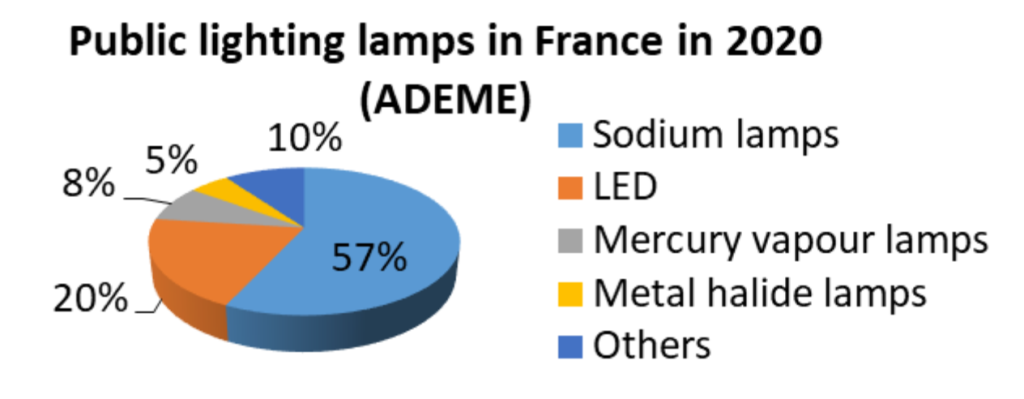Overview of public lighting in France
The energy consumption of public lighting in France is the second energy expense item for municipalities (after buildings), representing 20% of the energy bill of local authorities and 42% of their electricity consumption.

In 2020, public lighting in France represented 11 million light points (1 for 160 inhabitants on average). This number is increasing (+2 million in 5 years), but at the same time the average power of the sources and the number of hours of use at full power are both decreasing.
Taking into account that 40% of the luminaires are over 25 years old, that LED represents only 20% of the park, and the average power of a lamp is around 140W in 2020, the park could be seen as obsolete compared to current available technologies.
Despite this obsolescence, the renewal of the lighting stock was only 3% before the war in Ukraine. If this figure were to rise, it would still take 20 years to renew the entire stock.
Management of public lightings in France
The French management model is based on a dedicated power supply network for public lighting. Most public lighting networks use on/off control by astronomical clock and/or luminosity detection cell carried out at the electrical cabinet. Each cabinet controls 30 to 40 luminaires covering several streets.
| Key figures on the Auvergne-Rhône-Alpes region 13 energy syndicates 75% out of the 4 000 municipalities delegates their public lighting responsibilities to energy syndicates 875,000 street lamps in the region |
Many municipalities have already started implementing strategies to reduce the consumption of their street lighting. Between 2012 and 2017, the number of full power equivalent hours was reduced by 15%, mostly due to strategies of night-time extinction and to a lesser extent to the gradation of intensity enabled by LEDs.
Public lighting is a territorial collectivity responsibility (municipalities and metropoles). Metropoles own 20% of the French park and municipalities 80%. Whereas metropoles manage their public lighting on their own, most municipalities prefer to delegate their lighting responsibilities to their energy syndicate.
Depending on each energy syndicate strategy, municipalities can delegate only work or work and maintenance. Even through delegation, the municipality remains the owner and is therefore consulted by the energy syndicate before making any work or developing and public lighting strategy. This drives the decision-making process more complicated.
Energy performance contracts in France
In France, EPC including investment (Public Private Investment – PPP) are not used anymore since 2013, as they were proved to be too complicated (contracting complexity, limitation to big projects (>2 M€)).
Since then, another procedure of EPC excluding private investment, called global market procedure (=GMP) used, mostly by big cities and to a lesser extent by small municipalities keeping their public lighting authority.

Indeed, energy syndicates do not use GMP as they prefer keeping a strong hold on the public lighting management, with separate procedures for work, furniture, operation and maintenance. The length of GMP contracts varies between 6 to 12 years, with an average of 9 years.
Since 2022 and the energy crisis in Europe, GMPs are more and more used by big cities and municipalities, mostly for massive LED replacement and a reduction of the cost of public lighting.
GMP provides several advantages in such projects:
- On the financial point of view, GMPs ensures minimum reductions of energy consumption.
- It provides mid to long term strategies of investments considering the overall financial impact of the project.
- Despite the heavy investments that such projects represent, the quick payback times allow communities to commit to more ambitious multi-year investments.
- GMPs represent a simplification of administrative burden by putting in a single contract several assignments. And finally, it is an opportunity to subcontract technical difficulties while requiring a guarantee of results.
Smart lighting in France
Smart lighting in France is slowly developing in the past years. The projects identified in the region mostly focused on smart public lighting including remote control of night extinction and public events either at from the electric cabinet or on each lamp.
Some projects (less than 30 in France) include other smart services (mostly related to video surveillance alone), but a handful of projects are developing several services in a smart city approach with services. In this case, captors are mostly used for services such as building automation control system, waste management, and water management. Some cities experiments dedicated smart application, a test will be conducted in July 2023 on low power electric charging stations coupled with public lighting poles.
In conclusion, while smart lighting and EPC contracts represent a small part of current public lighting projects, they keep increasing, especially since 2022. This is largely due to the awareness on energy cost for municipalities and environmental issues as well as the need to better understand and manage public services in general.
